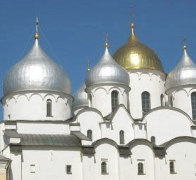Travel to Novgorod for Holidays

Trips to Novgorod for Holidays
As contradicting as it is, the city of Novgorod which means “new city” in Russian, is actually as old as Russia itself. Founded in the 10th century, the name implies there must have been an earlier settlement on the site, perhaps from the 9th century. Located 119 miles from St. Petersburg, Novgorod is north of Lake Ilmen and has long been divided by the Volkhov River which flows into Lake Ladoga, where it links with other waterways, including one to the east.
The waterways have contributed much to the economic position of Novgorod, which in turn has made the city a powerful center of cultural richness for over 500 years that is unique in Russia.
St. Sophia Cathedral of Novgorod
Novgorod’s kremlin, known as Detines (which means “strong boy”) is located in the west of the city and the left bank of the Volkhov. The five onion-domed towers of the St. Sophia Cathedral is the finest and largest building within the citadel of limestone. Built between 1045 and 1052, the cathedral has managed to withstand change and retain its simple and austere appearance. The enormous scale and dominance of powerful and heroic forms over quaint and poetic motifs found in the brick-built church are some of the characteristics of what was to later become recognized as a “Novgorod style”.
The facade of the cathedral is not beautified, and there is little remains of the ancient murals of the interior. The oldest and most valuable icon, St. Peter and St. Paul icon, is now in the Novgorod museum together with many other icons from Novgorod, which has been highly valued for their artistic merit.
In the 15th century, Novgorod had 150 churches and monasteries, many of which were commissioned by families, mercantile associations, and the bourgeois, and are less ostentatious than buildings constructed by the royal decree. The city had buildings such as the Yuriev Monastery, capped with domes in the form of military helmets, the church of St. Peter and St. Paul in Kosjevniki, and the Christ the King Cathedral with its superb frescoes that dominated the city for many centuries.
Considerable damage had been inflicted on the city’s churches and art treasures during World War II, but many of these monuments were carefully restored after the war, including the golden and silver domes of the Cathedral of St. Sophia.